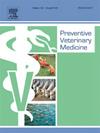High prevalence of Varroa destructor in Apis mellifera colonies from the largest honey producing state in Brazil
IF 2.4
2区 农林科学
Q1 VETERINARY SCIENCES
引用次数: 0
Abstract
Varroa destructor is regarded as a major threat to beekeeping worldwide. However, there are no official reports of V. destructor occurrence or related damage in Rio Grande do Sul, the largest honey producing state of Brazil. The present study aims to estimate the prevalence of V. destructor, identify its potential risk factors and perform spatial analysis according to the level of infestation of the colonies. A total of 1302 samples of adult honey bees from hives across 375 farms were analyzed. The overall prevalence of Varroa destructor was 95,16 %. The study revealed two risk factors for high infestation rate of V. destructor: scale of beekeeping and biome. Spatial analysis revealed that regions with the highest rates of mite infestation overlap with areas of the greatest apiary concentration. This study emphasizes the need to adopt minimum management practices to maintain strong and healthy colonies.
巴西最大产蜜州蜜蜂种群中破坏性瓦螨的高流行率
破坏者被认为是世界范围内养蜂业的主要威胁。然而,在巴西最大的蜂蜜生产州——南巴西格兰德州,并没有官方报告称发生了V. destructor或相关损害。本研究的目的是根据害虫种群的侵害程度,估计其流行程度,识别其潜在的危险因素,并进行空间分析。来自375个农场的蜂箱的1302个成年蜜蜂样本进行了分析。总患病率为95,16 %。研究发现,破坏夜蛾侵染率高的危险因素有两个:养蜂规模和生物群落。空间分析表明,螨侵害率最高的区域与蜂密度最高的区域重叠。这项研究强调需要采取最低限度的管理措施来维持强壮和健康的菌落。
本文章由计算机程序翻译,如有差异,请以英文原文为准。
求助全文
约1分钟内获得全文
求助全文
来源期刊

Preventive veterinary medicine
农林科学-兽医学
CiteScore
5.60
自引率
7.70%
发文量
184
审稿时长
3 months
期刊介绍:
Preventive Veterinary Medicine is one of the leading international resources for scientific reports on animal health programs and preventive veterinary medicine. The journal follows the guidelines for standardizing and strengthening the reporting of biomedical research which are available from the CONSORT, MOOSE, PRISMA, REFLECT, STARD, and STROBE statements. The journal focuses on:
Epidemiology of health events relevant to domestic and wild animals;
Economic impacts of epidemic and endemic animal and zoonotic diseases;
Latest methods and approaches in veterinary epidemiology;
Disease and infection control or eradication measures;
The "One Health" concept and the relationships between veterinary medicine, human health, animal-production systems, and the environment;
Development of new techniques in surveillance systems and diagnosis;
Evaluation and control of diseases in animal populations.
 求助内容:
求助内容: 应助结果提醒方式:
应助结果提醒方式:


